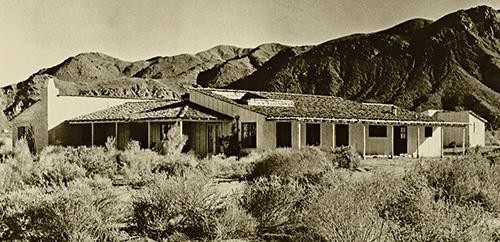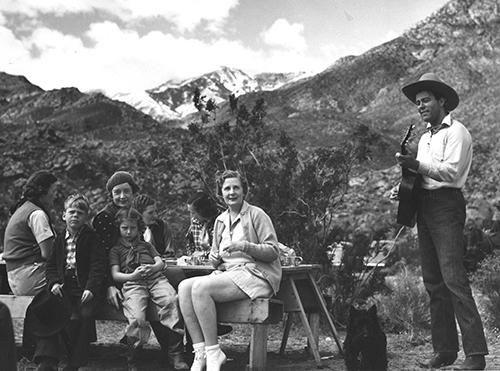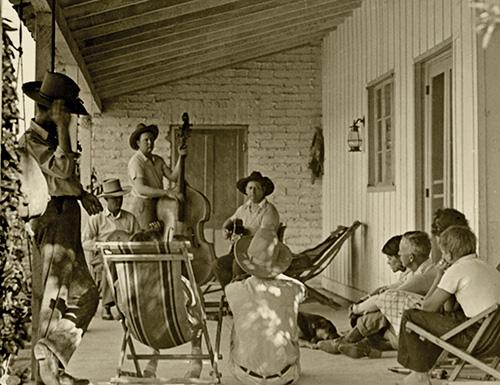Ranch History



Smoke Tree Ranch is not a newcomer to the desert scene. It has been a successful resort operation for more than sixty years.
Growth has been gradual and controlled since 1936, when Fred and Maziebelle Markham bought a shaky venture and quietly transformed it into a materialized dream.
The Markhams brought much more than financial stability to the Ranch. Mrs. Markham, gifted, charming, and warmly outgoing, managed, somehow, to combine an engaging light heartedness with a deep-seated spiritual side. A gracious hostess in their Altadena and Balboa Island homes, Maziebelle regarded the Ranch as merely an expanded version of a well-run home with many house guests. Mr. Markham, an astute businessman with widespread interests, did not view the Ranch as a moneymaking effort. Envisioned was a place where, free from pressures, like-minded people, with their families, could enjoy the desert.
Although the Ranch did not advertise or seek publicity, it became known to a cosmopolitan group who, as homeowners or guests, shared the Smoke Tree way of life. Ranch life was kept simple. No effort was made to impress. For to quote, "Most who have come here have been every place, seen everything, and done most things.
In its early days the Ranch was appropriately Western. Only barbed wire fences separated the Ranch from the surrounding desert. Western dress was not an affectation, but a practical choice. Ranch roads were dirt, kept under control by a rumbling sprinkler wagon and a scraper. Cowboys joined in the square dances called by the Ranch Foreman, to music chorded on the upright by his head-waitress wife.
Western singers, who lived on the Ranch, were ready, guitars at hand, to add to festivities. The Ranch Rodeo Field hosted professional rodeos and gymkhanas. Promptly (and only) at 6:30 p.m. dinner was served family-style at long, bare-topped wooden tables. Branded clothespins served a triple purpose -- napkin holder, place card, and hash mark record of prior visits (quite a status symbol). Alphabetically filed pins, awaiting the returning guests, lined the dining room walls. Had the computer not come along, this custom might have endured!
The set-up for Ranch children was ideal. Mornings were devoted to studies at the Ranch school, whose three buildings and playground stood along the west border of the Ranch, not far from the present gate. Afternoons were free for sports or family outings. Evening brought children and teachers together again for an early dinner, followed by stories and games in the lounge, while parents dined with their friends.
In 1945 there was a change in ownership, but not in policy or philosophy. The Markhams sold the entire Ranch operation to the Colony as a group. Colonists retained individual ownership of their homes and home sites.
As Colonists, the Markhams continued their interest in Ranch affairs, an interest which has now passed on to their children and grandchildren. Eighty-five homes now make up the Colony. Owners continue to be active in preserving their heritage and in furthering the ideals which brought it into existence.
Of the approximately 400 acres of Ranch land, 300+ acres are reserved for the Colony and 20 acres for the Guest Ranch. A part of the remaining acreage, acting as a buffer strip along East Palm Canyon Drive, is leased for the Smoke Tree Village and Smoke Tree Commons shopping centers. At the opposite end of the Ranch, land is leased for the stables.
A Board of Directors is elected by the Colonists to administer Ranch affairs. Appointed committees assist in various aspects of Ranch life. An experienced, professional General Manager, board-selected, heads the Guest Ranch operations. Assisting in the complex setup are carefully chosen employees with expertise in many fields.
The focal point of Smoke Tree is the Guest Ranch. All facilities including the Ranch House, Dining Room, Kiva, Disney Hall, swimming pool, bowling green, and tennis courts serve both Colonists and Guests. Programs, parties, and activities are planned with both groups in mind.
Long before Smoke Tree, a different development had been planned for the present Ranch land. In 1887, when thousands of acres of desert became available to speculators, a group of land promoters chose the alluvial fan north of Smoke Tree Mountain as the best site for an elaborately planned venture.
Here would rise the City of Palmdale, complete with parks and public buildings. A narrow- gauge railroad would be built to connect with the Southern Pacific Railroad. Residents would grow melons, grapes, and citrus in the mineral-rich soil. Water would flow through a stone-lined irrigation ditch. The narrow-gauge railroad was completed in good operating condition, and the ditch was ready for use just as the project collapsed. The tracks were taken up, and the Palmdale dream faded away.
The adobe ruins, preserved on the Ranch today, were long thought to have been the depot for the narrow-gauge railroad. Research proved this unlikely and suggested an unrelated undertaking begun a few years after the Palmdale fiasco. A dig at the old adobe in the summer of 1983 yielded artifacts placing fruit packing activity as late as 1895. A devastating drought at this time, combined with a shutdown of Indian-controlled water, ended this effort. The adobe was cannibalized and abandoned. The desert again undisturbed waited some forty years for Smoke Tree's successful and acceptable use of this lovely land.





